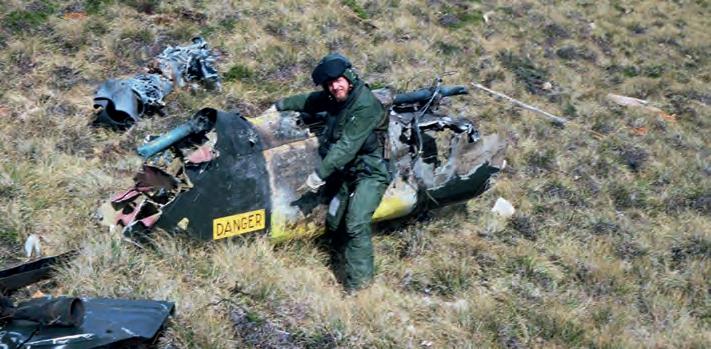
3 minute read
Contents Foreword
On April 2, 1982, Argentine forces invaded the Falkland Islands and three days later the Task Force sailed from Portsmouth with every Sea Harrier in the country; a total of 21 aircraft against a possible force of around 140 Argentine fast-jets. Not the kind of odds that one would normally plan to have for such an endeavour but we were confident that we would acquit ourselves well.
We saw our first action on May 1, when Hermes launched a nine-ship attack on Stanley airfield, with the remaining three aircraft attacking Goose Green. These attacks caused chaos, destroying numerous aircraft on the ground and the only damage sustained by us was when I was hit in the tail by a 20mm Rheinmetall anti-aircraft gun. Later that day, SHAR Combat Air Patrols intercepted a number of Argentine aircraft, resulting in the downing of a Canberra bomber, a Dagger (Israeli-built Mirage V) and two Mirage III supersonic fighters. This was our baptism of fire and set the tone for the next six weeks of fighting.
sortie with Lt David Smith so that we could land back after dark and become qualified to fly at night. In the event, we were scrambled to cover the Sir Tristram and Sir Galahad, that had been attacked by Skyhawks in Port Pleasant, to the southwest of Stanley.
We arrived to find both ships burning fiercely and several helicopters trying to evacuate the members of the Welsh Guards. After 40 minutes on CAP, I picked up a formation of Skyhawks attacking a small landing craft to the south of us and plunged down at very high speed to try to head them off. Unfortunately, I was unable to prevent the landing craft from being hit but in the following few seconds, I shot down two Skyhawks with AIM-9L missiles and engaged a third with guns, despite my gunsight having gone unserviceable as I fired the second missile.
Author and artist: Chris Sandham-Bailey
Design: Burda Druck India Pvt. Ltd.
Publisher: Steve O’Hara
Published by: Mortons Media Group Ltd, Media Centre, Morton Way, Horncastle, Lincolnshire LN9 6JR Tel. 01507 529529
Printed by: William Gibbons and Sons, Wolverhampton
ISBN: 978-1-911639-93-0
© 2022 Mortons Media Group Ltd. All rights reserved. No part of this publication may be reproduced or transmitted in any form or by any means, electronic or mechanical, including photocopying, recording, or any information storage retrieval system without prior permission in writing from the publisher.
Acknowledgements: Thanks to David Morgan, Brian Johnstone, Simon Jones, Rowland White, Santiago Rivas and Nick Greenall whose knowledge and time has been invaluable.
Our operations were hampered by truly awful weather, with savage storms, very poor visibility and huge seas. The SHAR coped with these conditions far better than any other carrier-borne aircraft could have hoped to and its ability to hover alongside and pick the best time in the ship’s cycle to land was truly vital. On a number of occasions, we flew with a cloud base of less than 100ft and on one such day, I had to climb into cloud to land!
I claimed my first air-to-air kills on May 23, a couple of days after the amphibious landings in San Carlos Water. I intercepted four helicopters heading for Port Howard on West Falkland and knocked the lead Puma out of the sky by flying very low over his rotor-head. I then took out the A109A gunship escort with 30mm cannon fire before taking the tailboom off a second Puma on the ground, with my last remaining Aden rounds.
During the conflict, I flew 53 SHAR missions and my final action took place on June 8. I was scheduled to fly a dusk
Smith fired a missile and brought down the third attacker at maximum range and we both recovered to Hermes with less than two minutes worth of fuel remaining. Luckily, they kept the bar open for us!
During the conflict, SHARs were responsible for the downing of 21 enemy aircraft, the sinking of two ships and the disabling of two further ones. We did not lose a single aircraft in air combat, although we did lose two to ground fire, two in bad weather and a further one that slipped off HMS Invincible’s deck during hard manoeuvring.
The SHAR proved itself to be a remarkable aircraft and a great credit to British Aerospace and those with the vision to design it. It truly was one of a kind and was loved by all who flew it or worked on it. It was both the most demanding and the most enjoyable aircraft that I have ever had the pleasure to fly. Despite its limitations in range and speed, its adaptability made it a supremely versatile fighter and without it, the Falklands could simply not have been retaken.
David Morgan



